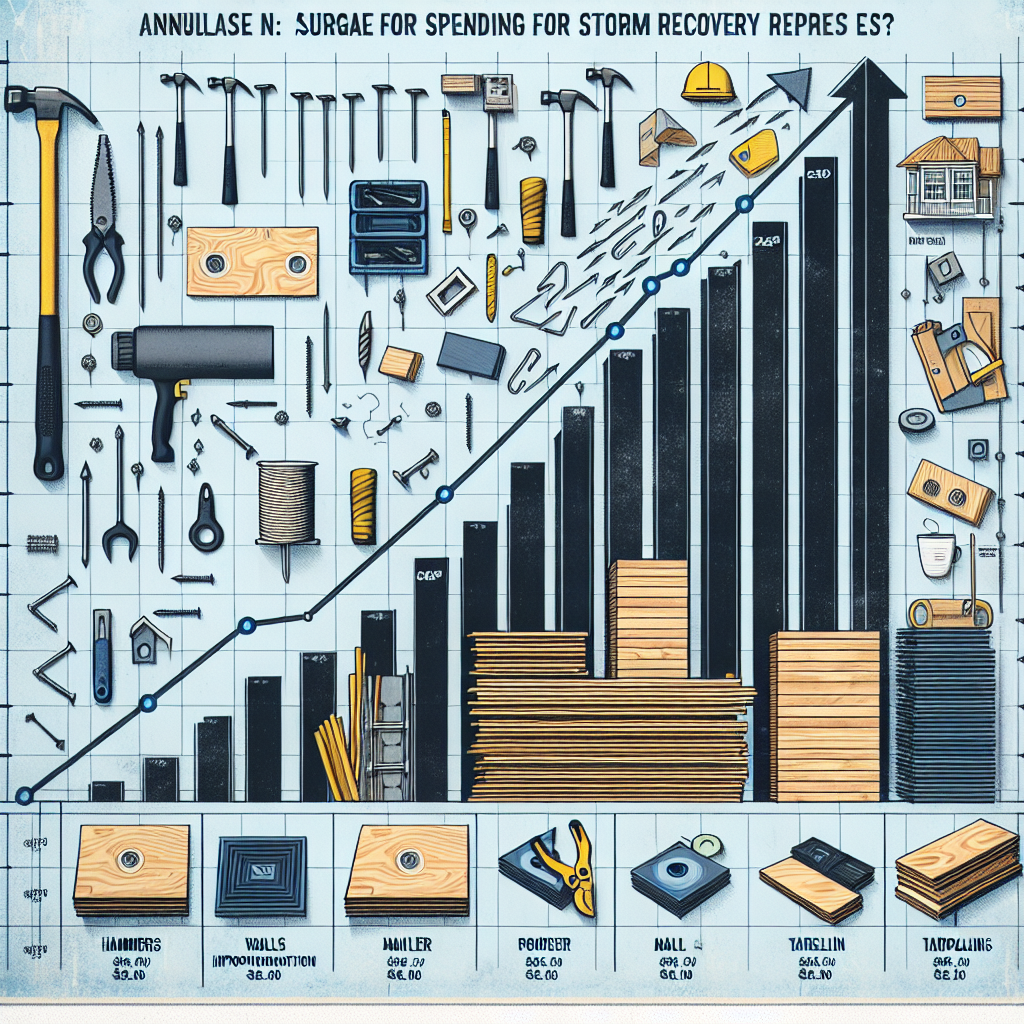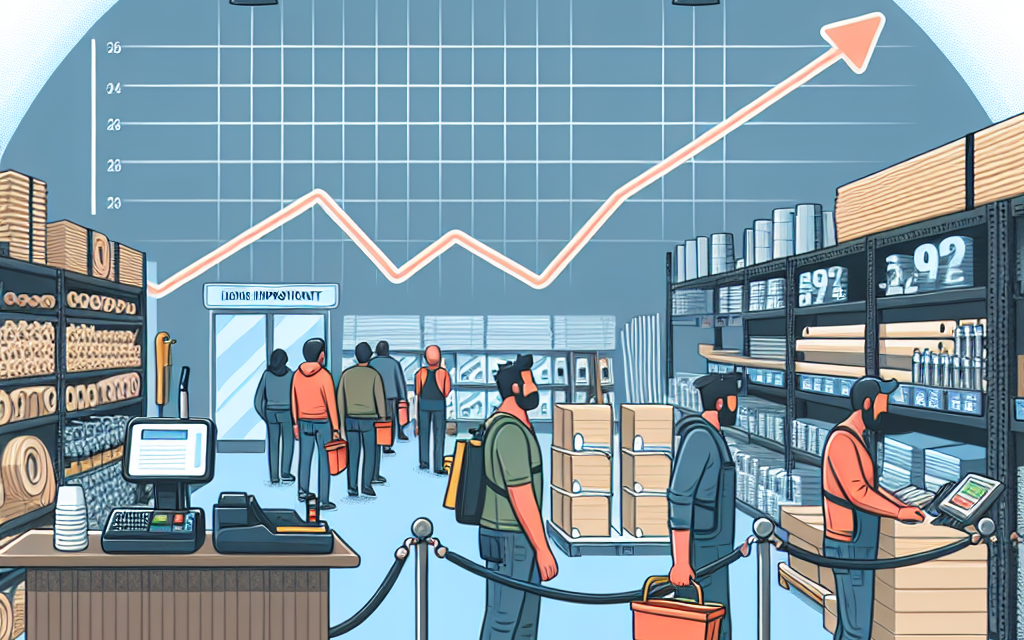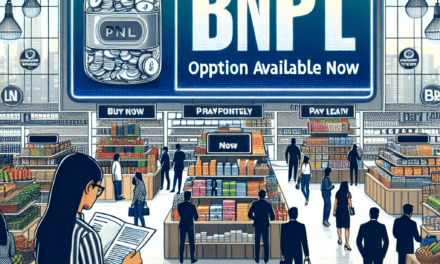“Building Resilience: Lowe’s Sales Surge Amid Storm Recovery Efforts”
Introduction
Lowe’s, a leading home improvement retailer, has revised its annual sales forecast upwards, driven by a surge in consumer spending on storm recovery efforts. This adjustment reflects the increased demand for building materials, tools, and home repair services as communities rebuild and fortify their homes in the aftermath of recent severe weather events. The company’s strategic focus on providing essential products and services for disaster recovery has positioned it to capitalize on this heightened market activity, underscoring its role as a critical resource for homeowners and contractors during times of crisis. As a result, Lowe’s anticipates stronger financial performance, bolstered by the urgent need for restoration and resilience-building supplies.
Impact Of Storm Recovery On Lowe’s Sales Forecast
Lowe’s, a leading home improvement retailer, has recently revised its annual sales forecast upwards, attributing this adjustment to a significant boost in spending related to storm recovery efforts. This development underscores the intricate relationship between natural disasters and economic activity, particularly in sectors like home improvement, where demand can surge in the aftermath of severe weather events. As communities grapple with the aftermath of storms, the need for rebuilding and repairs becomes paramount, driving consumers to seek out materials and services that facilitate recovery. Consequently, companies like Lowe’s find themselves at the forefront of this increased demand, providing essential supplies and expertise to aid in the restoration process.
The decision to increase the sales forecast is not made lightly, as it reflects a careful analysis of market conditions and consumer behavior. In the wake of recent storms, many regions have experienced widespread damage to homes and infrastructure, necessitating immediate attention and resources. This urgency translates into heightened activity at home improvement stores, where individuals and contractors alike flock to purchase everything from lumber and roofing materials to tools and appliances. Lowe’s, with its extensive network of stores and comprehensive product offerings, is well-positioned to meet these needs, thereby capturing a larger share of the market during these critical periods.
Moreover, the impact of storm recovery on Lowe’s sales is not merely a short-term phenomenon. As communities embark on the long road to recovery, the demand for home improvement products often extends beyond the initial aftermath of a storm. This sustained demand is driven by the ongoing nature of repair and rebuilding projects, which can span months or even years. As a result, Lowe’s can anticipate a steady stream of business as affected areas continue to rebuild and fortify their homes against future weather events. This extended timeline of recovery efforts ensures that the company remains a vital resource for consumers seeking to restore their properties to pre-storm conditions.
In addition to the immediate and long-term sales opportunities presented by storm recovery, Lowe’s also benefits from its strategic initiatives aimed at enhancing customer experience and operational efficiency. By investing in technology and supply chain improvements, the company is better equipped to handle surges in demand and ensure that products are readily available to those in need. These efforts not only bolster Lowe’s ability to serve its customers effectively but also contribute to its overall financial performance, reinforcing the positive outlook reflected in the revised sales forecast.
Furthermore, Lowe’s commitment to community support and disaster relief initiatives plays a crucial role in its response to storm recovery efforts. By partnering with local organizations and providing resources to affected areas, the company demonstrates its dedication to helping communities rebuild and thrive. This approach not only strengthens Lowe’s reputation as a responsible corporate citizen but also fosters customer loyalty, as consumers are more likely to support businesses that actively contribute to the well-being of their communities.
In conclusion, the increase in Lowe’s annual sales forecast highlights the significant impact of storm recovery on the home improvement sector. As natural disasters continue to pose challenges for communities, companies like Lowe’s are poised to play a critical role in facilitating recovery and rebuilding efforts. Through strategic investments and a commitment to community support, Lowe’s is well-positioned to capitalize on the opportunities presented by storm recovery, ensuring its continued growth and success in the face of adversity.
How Natural Disasters Influence Retail Growth
Lowe’s, a prominent player in the home improvement retail sector, has recently revised its annual sales forecast upwards, attributing this adjustment to a surge in spending driven by storm recovery efforts. This development underscores the intricate relationship between natural disasters and retail growth, highlighting how unforeseen environmental events can significantly impact consumer behavior and, consequently, the financial performance of businesses.
Natural disasters, while devastating in their immediate effects, often lead to a paradoxical boost in certain economic sectors, particularly those related to construction and home improvement. When storms, hurricanes, or other catastrophic events occur, they leave behind a trail of destruction that necessitates extensive repair and rebuilding efforts. This, in turn, creates a heightened demand for construction materials, tools, and other related products, which retailers like Lowe’s are well-positioned to supply. As communities embark on recovery and rebuilding projects, they inevitably turn to these retailers for the necessary supplies, thereby driving up sales.
Moreover, the impact of natural disasters on retail growth is not limited to the immediate aftermath. The process of recovery and rebuilding can extend over months or even years, providing a sustained boost to sales for companies involved in the supply of building materials and home improvement products. This prolonged demand can lead to a more stable and predictable revenue stream for retailers, allowing them to plan and forecast with greater accuracy. Consequently, companies like Lowe’s can adjust their sales forecasts to reflect this increased demand, as evidenced by their recent announcement.
In addition to the direct demand for materials and tools, natural disasters also influence consumer behavior in more subtle ways. For instance, the experience of living through a storm or hurricane can lead to a heightened awareness of the need for preparedness and resilience. This awareness often translates into increased spending on products that enhance home safety and security, such as generators, storm shutters, and emergency supplies. Retailers that offer a wide range of these products can capitalize on this shift in consumer priorities, further boosting their sales figures.
Furthermore, the role of government and insurance companies in the recovery process cannot be overlooked. Financial assistance and insurance payouts often provide the necessary funds for individuals and businesses to undertake repair and rebuilding projects. This influx of capital into affected areas can stimulate local economies and, by extension, increase spending at retail outlets. Retailers that are able to effectively tap into this flow of funds can experience significant growth in their sales, as evidenced by Lowe’s recent forecast adjustment.
While the relationship between natural disasters and retail growth is complex, it is clear that companies like Lowe’s are adept at navigating these challenges and capitalizing on the opportunities they present. By understanding the dynamics of consumer behavior in the wake of environmental events, retailers can position themselves to meet the increased demand for their products and services. As Lowe’s continues to adjust its strategies in response to these factors, it serves as a compelling example of how businesses can adapt to and thrive in the face of adversity. In conclusion, the interplay between natural disasters and retail growth is a testament to the resilience and adaptability of both consumers and businesses in the ever-changing economic landscape.
Lowe’s Strategic Response To Increased Demand
Lowe’s Companies, Inc., a prominent player in the home improvement retail sector, has recently revised its annual sales forecast upward, attributing this adjustment to a surge in demand driven by storm recovery efforts. This strategic response underscores Lowe’s agility in adapting to market dynamics and highlights its commitment to meeting customer needs during critical times. As communities across various regions grapple with the aftermath of severe weather events, the demand for home repair and improvement products has seen a significant uptick. Consequently, Lowe’s has positioned itself to capitalize on this increased demand, ensuring that it remains a reliable partner for homeowners and contractors alike.
In the wake of recent storms, many homeowners are faced with the daunting task of repairing and fortifying their properties. This has led to a heightened need for building materials, tools, and other essential supplies. Recognizing this opportunity, Lowe’s has strategically bolstered its inventory, ensuring that its stores are well-stocked with the necessary products to support recovery efforts. By doing so, the company not only addresses immediate customer needs but also strengthens its market position in the competitive home improvement landscape.
Moreover, Lowe’s has implemented several initiatives to enhance its operational efficiency and customer service during this period of increased demand. For instance, the company has streamlined its supply chain processes to expedite the delivery of critical products to affected areas. This proactive approach minimizes potential disruptions and ensures that customers have timely access to the resources they require. Additionally, Lowe’s has invested in training its staff to provide expert guidance and support to customers navigating the complexities of storm recovery projects.
Furthermore, Lowe’s commitment to community support extends beyond mere product availability. The company has actively engaged in partnerships with local organizations and relief agencies to provide assistance to those most affected by the storms. Through these collaborations, Lowe’s has facilitated the distribution of essential supplies and resources to vulnerable communities, reinforcing its role as a socially responsible corporate entity.
As Lowe’s navigates this period of heightened demand, it remains focused on long-term growth and sustainability. The company is leveraging data analytics and customer insights to refine its product offerings and enhance the overall shopping experience. By understanding evolving consumer preferences and needs, Lowe’s can tailor its strategies to better serve its diverse customer base.
In addition to its immediate response to storm recovery needs, Lowe’s is also exploring opportunities to expand its product lines and services. This includes investing in innovative solutions that cater to the growing interest in sustainable and energy-efficient home improvement options. By aligning its offerings with emerging trends, Lowe’s is well-positioned to capture new market segments and drive future growth.
In conclusion, Lowe’s decision to increase its annual sales forecast reflects its strategic response to the surge in demand resulting from storm recovery efforts. Through a combination of enhanced inventory management, operational efficiency, and community engagement, the company has demonstrated its ability to adapt to changing market conditions while maintaining a strong focus on customer satisfaction. As Lowe’s continues to navigate this dynamic landscape, its commitment to innovation and sustainability will undoubtedly play a pivotal role in shaping its future success.
The Role Of Home Improvement Retailers In Disaster Recovery

In the wake of recent natural disasters, the role of home improvement retailers has become increasingly significant in facilitating recovery efforts. Lowe’s, a leading name in the home improvement sector, has recently adjusted its annual sales forecast upwards, attributing this change to a surge in spending driven by storm recovery activities. This development underscores the critical function that such retailers play in disaster-stricken areas, providing essential materials and support to communities in need.
Natural disasters, including hurricanes, floods, and severe storms, often leave a trail of destruction that necessitates immediate and extensive repair and rebuilding efforts. In these situations, home improvement retailers like Lowe’s become indispensable resources for affected homeowners and businesses. They supply the necessary tools, materials, and expertise required to restore damaged properties. As communities embark on the arduous journey of recovery, the demand for construction materials, repair tools, and other related products inevitably rises, leading to increased sales for these retailers.
Lowe’s recent decision to revise its sales forecast is a direct reflection of this dynamic. The company has observed a notable uptick in customer purchases related to storm recovery, which has positively impacted its financial outlook. This trend is not only beneficial for Lowe’s but also indicative of a broader economic pattern where disaster recovery efforts stimulate local economies. By providing essential goods and services, home improvement retailers contribute to the revitalization of affected areas, helping to restore normalcy and stability.
Moreover, the role of retailers like Lowe’s extends beyond merely supplying materials. They often engage in community support initiatives, offering expertise and guidance to those undertaking repair projects. This assistance can be invaluable, particularly for individuals who may lack the experience or knowledge required to tackle complex restoration tasks. By offering workshops, how-to guides, and personalized advice, these retailers empower homeowners to take charge of their recovery efforts, fostering a sense of resilience and self-sufficiency.
In addition to their direct contributions to recovery efforts, home improvement retailers also play a crucial role in promoting preparedness and resilience against future disasters. By advocating for the use of durable materials and encouraging the adoption of resilient building practices, they help communities build back stronger and more sustainably. This proactive approach not only mitigates the impact of future disasters but also enhances the long-term safety and security of affected areas.
Furthermore, the economic impact of increased spending on storm recovery extends beyond the immediate sales boost for retailers. It also generates employment opportunities, both within the retail sector and in related industries such as construction and logistics. As demand for materials and services rises, so too does the need for skilled labor, creating jobs and supporting local economies. This ripple effect highlights the interconnected nature of disaster recovery efforts and the pivotal role that home improvement retailers play in this complex ecosystem.
In conclusion, Lowe’s decision to increase its annual sales forecast in response to heightened storm recovery spending underscores the vital role that home improvement retailers occupy in disaster recovery. By providing essential materials, expertise, and support, they facilitate the rebuilding process and contribute to the economic revitalization of affected communities. As natural disasters continue to pose significant challenges, the importance of these retailers in fostering resilience and recovery cannot be overstated.
Analyzing Lowe’s Financial Performance Amid Storm Recovery
Lowe’s, a prominent player in the home improvement retail sector, has recently revised its annual sales forecast upwards, attributing this adjustment to a surge in spending driven by storm recovery efforts. This development comes as a response to the increased demand for building materials and home repair services following a series of severe weather events that have impacted various regions. As communities embark on the arduous journey of rebuilding and repairing damaged properties, Lowe’s has positioned itself as a critical resource, providing essential supplies and expertise to aid in recovery efforts.
The decision to increase the sales forecast reflects Lowe’s strategic agility in capitalizing on emergent market conditions. In the wake of natural disasters, there is often a heightened need for construction materials, tools, and home improvement services, as individuals and businesses strive to restore normalcy. Lowe’s, with its extensive network of stores and robust supply chain, is well-equipped to meet this demand, ensuring that customers have access to the necessary resources for their recovery projects. This ability to swiftly respond to market dynamics underscores Lowe’s commitment to serving its customers while simultaneously driving its financial performance.
Moreover, the upward revision of the sales forecast is indicative of Lowe’s broader financial health and operational resilience. Despite the challenges posed by fluctuating economic conditions and supply chain disruptions, the company has demonstrated a capacity to adapt and thrive. By leveraging its strong vendor relationships and optimizing inventory management, Lowe’s has been able to maintain product availability and competitive pricing, thereby enhancing customer satisfaction and loyalty. This strategic focus on operational excellence has not only bolstered sales but also reinforced Lowe’s reputation as a reliable partner in times of need.
In addition to the immediate impact of storm recovery spending, Lowe’s is also benefiting from long-term trends in the home improvement industry. The ongoing emphasis on home renovation and remodeling, fueled by changing consumer preferences and the rise of remote work, has created sustained demand for home improvement products and services. Lowe’s has adeptly tapped into this trend by expanding its product offerings and enhancing its digital capabilities, providing customers with a seamless shopping experience both in-store and online. This dual-channel approach has enabled Lowe’s to capture a broader customer base and drive incremental sales growth.
Furthermore, Lowe’s commitment to community engagement and corporate social responsibility has played a pivotal role in its financial performance amid storm recovery efforts. By actively participating in disaster relief initiatives and supporting local communities, Lowe’s has strengthened its brand image and fostered goodwill among customers. This alignment of business objectives with social impact has not only contributed to sales growth but also reinforced Lowe’s position as a socially responsible corporate entity.
In conclusion, Lowe’s decision to increase its annual sales forecast is a testament to its strategic foresight and operational prowess. By effectively responding to the surge in demand driven by storm recovery efforts, Lowe’s has demonstrated its ability to navigate complex market conditions and deliver value to its stakeholders. As the company continues to build on its strengths and capitalize on emerging opportunities, it remains well-positioned to sustain its growth trajectory and maintain its leadership in the home improvement retail sector.
Consumer Spending Trends Post-Storm Events
In the wake of recent storm events, Lowe’s has revised its annual sales forecast upward, attributing this adjustment to a surge in consumer spending on recovery and rebuilding efforts. This trend highlights a broader pattern in consumer behavior following natural disasters, where the immediate aftermath often sees a spike in demand for home improvement and repair supplies. As communities grapple with the destruction left by severe weather, the need for materials to repair roofs, replace damaged structures, and fortify homes against future incidents becomes paramount. Consequently, retailers like Lowe’s, which specialize in home improvement, find themselves at the forefront of this economic activity.
The increase in Lowe’s sales forecast is not merely a reflection of opportunistic business practices but rather an indication of the essential role such retailers play in disaster recovery. When storms strike, they leave behind a trail of damage that requires urgent attention. Homeowners and businesses alike turn to stores like Lowe’s for the necessary tools and materials to begin the rebuilding process. This surge in demand is often immediate and sustained, as initial repairs give way to more comprehensive rebuilding projects. As a result, companies in the home improvement sector often experience a notable uptick in sales during these periods.
Moreover, the impact of storm recovery spending extends beyond the immediate purchase of materials. It also influences broader economic trends, as increased consumer spending in this sector can stimulate local economies. The influx of funds into communities affected by storms can lead to job creation, as contractors and construction workers are hired to undertake repair and rebuilding projects. This, in turn, can have a multiplier effect, as those employed in recovery efforts spend their earnings on local goods and services, further bolstering economic activity.
However, it is important to recognize that while storm recovery spending can provide a temporary boost to certain sectors, it also underscores the vulnerability of communities to natural disasters. The increased sales forecast for Lowe’s, while beneficial for the company, is a reminder of the challenges faced by those affected by storms. The financial burden of recovery can be significant, and not all individuals or businesses have the resources to fully restore their properties. This highlights the need for comprehensive disaster preparedness and resilience planning, both at the individual and community levels.
In addition, the pattern of increased consumer spending post-storm events raises questions about the sustainability of such economic boosts. While the immediate aftermath of a storm can lead to increased sales for home improvement retailers, it is crucial to consider the long-term implications. As climate change continues to influence weather patterns, the frequency and intensity of storms may increase, leading to more frequent cycles of destruction and rebuilding. This could place a strain on both consumers and businesses, as the costs associated with repeated recovery efforts mount.
In conclusion, Lowe’s decision to increase its annual sales forecast in response to storm recovery spending reflects a broader trend in consumer behavior following natural disasters. While this surge in demand can provide a temporary economic boost, it also highlights the challenges and vulnerabilities faced by affected communities. As such, it is essential for both individuals and policymakers to prioritize resilience and preparedness to mitigate the impact of future storms.
Lowe’s Competitive Advantage In The Home Improvement Sector
Lowe’s Companies, Inc., a prominent player in the home improvement retail sector, has recently revised its annual sales forecast upwards, attributing this adjustment to a surge in spending driven by storm recovery efforts. This development underscores Lowe’s competitive advantage in the industry, as the company continues to leverage its strategic positioning and operational strengths to capitalize on market opportunities. The increased forecast not only reflects Lowe’s ability to respond effectively to external factors but also highlights its resilience and adaptability in a dynamic market environment.
In the wake of recent storms, homeowners and businesses have been prompted to undertake significant repair and renovation projects, leading to a heightened demand for home improvement products and services. Lowe’s, with its extensive network of stores and comprehensive product offerings, is well-positioned to meet this demand. The company’s ability to quickly mobilize resources and ensure the availability of essential supplies has been instrumental in capturing a larger share of the market during this period of increased activity.
Moreover, Lowe’s strategic investments in supply chain enhancements and technology have further strengthened its competitive edge. By optimizing inventory management and streamlining logistics, the company has been able to maintain product availability and minimize disruptions, even in the face of heightened demand. This operational efficiency not only enhances customer satisfaction but also reinforces Lowe’s reputation as a reliable and responsive retailer in the home improvement sector.
In addition to its operational strengths, Lowe’s commitment to customer service and community engagement has played a crucial role in solidifying its market position. The company has consistently prioritized customer needs, offering personalized solutions and expert advice to assist homeowners in their recovery efforts. This customer-centric approach has fostered loyalty and trust, enabling Lowe’s to build lasting relationships with its clientele.
Furthermore, Lowe’s proactive involvement in community support initiatives has enhanced its brand image and strengthened its ties with local communities. By providing resources and assistance to areas affected by storms, the company has demonstrated its dedication to social responsibility and community well-being. This commitment not only differentiates Lowe’s from its competitors but also aligns with the growing consumer preference for socially responsible businesses.
As Lowe’s continues to navigate the evolving landscape of the home improvement sector, its focus on innovation and sustainability remains a key driver of its competitive advantage. The company has been at the forefront of introducing eco-friendly products and sustainable practices, catering to the increasing demand for environmentally conscious solutions. By integrating sustainability into its business model, Lowe’s not only addresses consumer preferences but also positions itself as a leader in the transition towards a more sustainable future.
In conclusion, Lowe’s upward revision of its annual sales forecast, driven by storm recovery spending, highlights the company’s robust competitive advantage in the home improvement sector. Through strategic investments, operational excellence, and a commitment to customer service and community engagement, Lowe’s has effectively capitalized on market opportunities and reinforced its position as a leading retailer. As the company continues to innovate and prioritize sustainability, it is well-equipped to navigate future challenges and maintain its competitive edge in an ever-evolving industry landscape.
Q&A
1. **What prompted Lowe’s to increase its annual sales forecast?**
Lowe’s increased its annual sales forecast due to a boost in spending related to storm recovery efforts.
2. **How do storms impact Lowe’s sales?**
Storms often lead to increased demand for home repair and improvement products, as people repair and rebuild damaged properties.
3. **What types of products see increased sales after storms?**
Products such as roofing materials, generators, plywood, and other home repair supplies typically see increased sales after storms.
4. **How does storm recovery spending affect Lowe’s financial performance?**
Storm recovery spending can lead to higher sales and revenue, positively impacting Lowe’s financial performance.
5. **Did Lowe’s report any specific regions contributing to the sales increase?**
While specific regions may not be detailed, areas affected by recent storms are likely contributors to the sales increase.
6. **How does Lowe’s prepare for increased demand following storms?**
Lowe’s prepares by ensuring adequate inventory, staffing, and logistical support to meet the surge in demand.
7. **What is the broader impact of storm recovery on the home improvement industry?**
Storm recovery can lead to a temporary boost in sales across the home improvement industry as companies supply necessary materials and services for rebuilding efforts.
Conclusion
Lowe’s has revised its annual sales forecast upwards, attributing the increase to a surge in spending related to storm recovery efforts. This adjustment reflects the heightened demand for home improvement products and services as affected communities invest in repairs and rebuilding. The boost in sales underscores the company’s strategic positioning to capitalize on such unforeseen events, highlighting its role in providing essential supplies and support during recovery periods. This forecast adjustment not only indicates a short-term financial uplift for Lowe’s but also reinforces its market resilience and capacity to respond effectively to external challenges.





